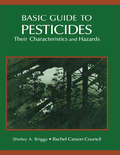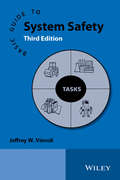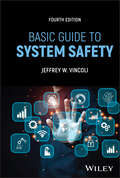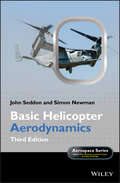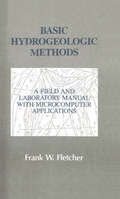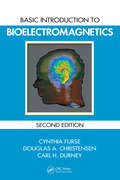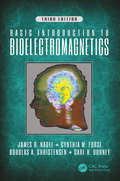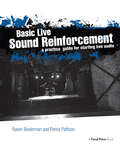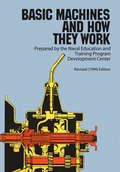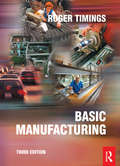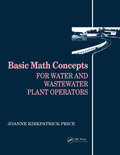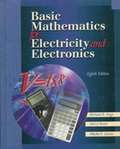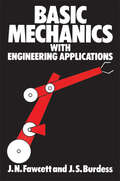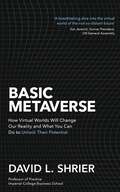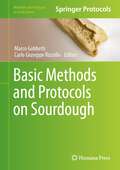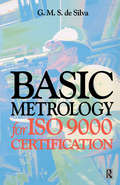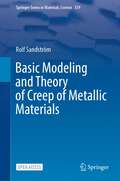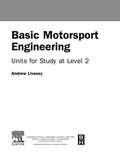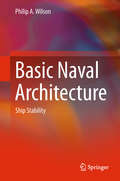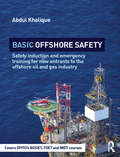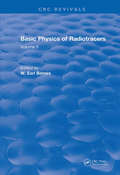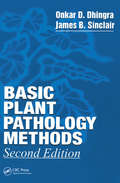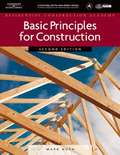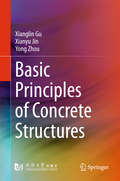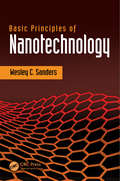- Table View
- List View
Basic Guide To Pesticides: Their Characteristics & Hazards
by Rachel Carson Counsel Inc.This work contains physical properties of over 700 pesticides and transformation products and contaminants. It can be used by the layman with minor questions or by the specialist needing in-depth references. Facts have been arranged so that one does not have to read through lengthy material.
Basic Guide to System Safety
by Jeffrey W. VincoliThis book provides guidance on including prevention through design concepts within an occupational safety and health management system. Through the application of these concepts, decisions pertaining to occupational hazards and risks can be incorporated into the process of design and redesign of work premises, tools, equipment, machinery, substances, and work processes including their construction, manufacture, use, maintenance, and ultimate disposal or reuse. These techniques provide guidance for a life-cycle assessment and design model that balances environmental and occupational safety and health goals over the life span of a facility, process, or product.The new edition is expanded to include primer information on the use of safety assurance techniques in design and construction.
Basic Guide to System Safety
by Jeffrey W. VincoliBASIC GUIDE TO SYSTEM SAFETY Instructional guide applying “prevention through design” concepts to the design and redesign of work premises, tools, equipment, and processes Basic Guide to System Safety provides guidance on including prevention through design concepts within an occupational safety and health management system; through the application of these concepts, decisions pertaining to occupational hazards and risks can be incorporated into the process of design and redesign of work premises, tools, equipment, machinery, substances, and work processes, including their construction, manufacture, use, maintenance, and ultimate disposal or reuse. These techniques provide guidance for a life-cycle assessment and design model that balances environmental and occupational safety and health goals over the lifespan of a facility, process, or product. The updated Fourth Edition reflects current and emerging industry practices and approaches, providing an essential periodic review of the text to ensure its contents adequately meet the requirements of academia as well as other users in the occupational safety and health profession. The book also features a new chapter on Prevention through Design (PtD) and how it is linked to System Safety Engineering and Analysis. Topics covered in Basic Guide to System Safety include: System safety criteria, including hazard severity and probability, the hazard risk matrix, and system safety precedence System safety efforts, including closed-loop hazard tracking systems, accident risk assessments, and mishap, accident, and incident reporting Fault or functional hazard analysis, management oversight and risk trees, HAZOP and what-if analyses, and energy trace and barrier analysis (ETBA) Sneak circuit analysis, including types and causes of sneaks, input requirements, and advantages and disadvantages of the technique Providing essential fundamentals for readers who may not have a background or pre-requisite in the subject, Basic Guide to System Safety is an ideal introductory resource for the practicing safety and health professionals, along with advanced students taking industrial safety courses.
Basic Helicopter Aerodynamics
by Simon Newman John M. SeddonBasic Helicopter Aerodynamics is widely appreciated as an easily accessible, rounded introduction to the first principles of the aerodynamics of helicopter flight. Simon Newman has brought this third edition completely up to date with a full new set of illustrations and imagery. An accompanying website www.wiley.com/go/seddon contains all the calculation files used in the book, problems, solutions, PPT slides and supporting MATLAB® code.Simon Newman addresses the unique considerations applicable to rotor UAVs and MAVs, and coverage of blade dynamics is expanded to include both flapping, lagging and ground resonance. New material is included on blade tip design, flow characteristics surrounding the rotor in forward flight, tail rotors, brown-out, blade sailing and shipborne operations.Concentrating on the well-known Sikorsky configuration of single main rotor with tail rotor, early chapters deal with the aerodynamics of the rotor in hover, vertical flight, forward flight and climb. Analysis of these motions is developed to the stage of obtaining the principal results for thrust, power and associated quantities. Later chapters turn to the characteristics of the overall helicopter, its performance, stability and control, and the important field of aerodynamic research is discussed, with some reference also to aerodynamic design practice.This introductory level treatment to the aerodynamics of helicopter flight will appeal to aircraft design engineers and undergraduate and graduate students in aircraft design, as well as practising engineers looking for an introduction to or refresher course on the subject.
Basic Hydrogeologic Methods: A Field and Laboratory Manual with Microcomputer Applications
by Frank FletcherThe approach of this book is how-to-do and hands-on. Its purpose is to provide clear, step-by-step instruction in many of the fundamental methods of hydrogeologic investigation. These methods include both 1) the traditional techniques of data analysis, such as mathematical computation by electronic calculator and construction of graphs by hand-plotting, and 2) microcomputer techniques employing electronic spreadsheets, graphing and gridding and contouring software. The microcomputer methods employ commercial software such as Lotus 1-2-3. Microsoft Excel, Quattro-Pro, Golden Software's Grapher and Surfer, and Geraghty and Miller's AQTESOLV. Although familiarity with any of the applications is helpful, the instructions in this manual assume no prior experience with them. Basic Hydrogeologic Methods is divided into three sections: Groundwater Occurrence and Movement, Groundwater Investigations, and Well and Aquifer Hydraulics. Each section begins with a brief summary of relevant terminology and principles. This introductory chapter is followed by a case study, which may be employed to provide a practical context for the hydrogeological methods that are described in subsequent chapters. Most of the methodological exercises culminate in an analytical product, such as data table, graph, contour map, etc., which readily serve as a focus for problem-solving activities, classroom discussions, and investigative reports. Many of the exercises present at least two investigative methods for accomplishing a particular hydrogeologic task. For example, time-drawdown graphs may be produced by a hand-plotting method or by a microcomputer method. For the professional scientist, the choice of a particular method might depend on such factors as the time available to carry out the task, the degree of accuracy required, or the availability of assessory equipment and materials.
Basic Introduction to Bioelectromagnetics
by Cynthia Furse Douglas A. Christensen Carl H. DurneyAlthough classical electromagnetic (EM) field theory is typically embedded in vector calculus and differential equations, many of the basic concepts and characteristics can be understood with precursory mathematical knowledge. Completely revised and updated, Basic Introduction to Bioelectromagnetics, Second Edition facilitates the process of interd
Basic Introduction to Bioelectromagnetics, Third Edition
by James Nagel Cynthia Furse Douglas A. Christensen Carl H. DurneyBasic Introduction to Bioelectromagnetics, Third Edition, is a primary source for medical technologists and life scientists seeking to understand how electromagnetic fields interact with the body, and how they are used in medical applications. Instead of the complex math commonly used when analyzing electromagnetics, this book uses graphical methods and simple equations. The third edition is updated with color graphics that show the fields in bright, clear colors. Each concept is presented with an associated discussion and application, including MRI, NMR, hyperthermia, neural stimulation, ultrasound, and cardiac pacing/defibrillation. Offering a simplified explanation of a very complex subject, this third edition provides an accessible introduction for life scientists and medical technologist on how EM fields work, what controls them, and the factors important to experimental setups and medical applications. This qualitative and illustrative book: Covers the entire frequency spectrum from direct current (DC) up through optical frequencies. Includes more than 200 illustrations, 65 in color, and 40 medical applications. Incorporates examples from real-world applications to explain concepts. Concentrates on the qualitative explanation of the key concepts, fundamental principles, and characteristic behaviors of EM fields, without complicated mathematics. Offers practical rules of thumb to understand real situations. Requires only a background in algebra, in contrast to typical EM books that require vector calculus and differential equations.
Basic Live Sound Reinforcement: A Practical Guide for Starting Live Audio
by Raven Biederman Penny PattisonAccess and interpret manufacturer spec information, find shortcuts for plotting measure and test equations, and learn how to begin your journey towards becoming a live sound professional. Land and perform your first live sound gigs with this guide that gives you just the right amount of information. Don't get bogged down in details intended for complex and expensive equipment and Madison Square Garden-sized venues. Basic Live Sound Reinforcement is a handbook for audio engineers and live sound enthusiasts performing in small venues from one-mike coffee shops to clubs. With their combined years of teaching and writing experience, the authors provide you with a thorough foundation of the theoretical and the practical, offering more advanced beginners a complete overview of the industry, the gear, and the art of mixing, while making sure to remain accessible to those just starting out.
Basic Machines and How They Work
by Naval EducationThis revised edition of an extremely clear Navy training manual leaves nothing to be desired in its presentation. Thorough in its coverage of basic theory, from the lever and inclined plane to internal combustion engines and power trains, it requires nothing more than an understanding of the most elementary mathematics. Beginning with the simplest of machines — the lever — the text proceeds to discussions of the block and tackle (pulleys and hoists), wheel and axle, the inclined plane and the wedge, the screw, and different types of gears (simple, spur, bevel, herringbone, spiral, worm, etc.). A chapter on the concept of work discusses the measurement of work, friction, and efficiency; this is followed by investigations of power, force, and pressure, with explanations of the uses of scales, balances, gauges, and barometers. The fundamentals of hydrostatic and hydraulic machines (such as the hydraulic braking system and the hydraulic press) are discussed in detail. The remaining chapters cover machine elements (bearings and springs), basic mechanisms (gear differential, couplings, cams, clutches), the internal combustion engine and power trains (including explanations of various transmission systems — synchromesh, auxiliary, etc.). Every concept is clearly defined, and discussions always build easily from elementary theory to specific applications familiar to anyone with the slightest interest in mechanics. Important concepts, machine components, and techniques are clearly illustrated in more than 200 diagrams, drawings, and cross-sections that reveal inner workings — all of these help to clarify even further an already clear and well-organized presentation. Although it was originally designed for use in U.S. Naval Training Schools, this book can be used to great advantage as a basic text in mechanical engineering in standard technical schools, and it will be immensely valuable even to lay readers who desire a basic knowledge of mechanics.
Basic Manufacturing
by Roger TimingsBasic Manufacturing has already established itself as a core text for manufacturing courses in Further Education. The new edition has been revised to be fully in line with the new Vocational GCSE in Manufacturing from Edexcel, covering the three compulsory units of this scheme, and will continue to act as a core text for Intermediate GNVQ. Coverage of the two schemes is combined throughout the text, yet each chapter clearly illustrates which sections map to which units within the two scheme specifications.The author's approach is student-centred with self-check questions and activities provided throughout. As a result, the book is well suited to independent study. It is also clearly written to appeal to students of all abilities. Review questions are provided at the end of each chapter to consolidate learning and give practice for external assessments.The third edition contains a brand new chapter to cater for the examinable part of the GCSE syllabus (Unit 3), which includes case studies in the six sectors covered in the scheme: food and drink/biological and chemical; printing and publishing/paper and board; textiles and clothing; engineering fabrication; mechanical/automotive engineering; electrical and electronic engineering/computer/process control/telecommunications.The book is an excellent, readable introduction to the technical and business aspects of the manufacturing industry that will be invaluable for students on a wide range of courses, including City and Guilds certificates. It also provides a good grounding for students embarking on higher-level programmes within Manufacturing.Roger Timings is one of the UK's leading authors of textbooks on manufacturing and engineering.
Basic Math Concepts: For Water and Wastewater Plant Operators (Mathematics for Water and Wastewater Treatment Plant Operators)
by Joanne K. PriceFROM THE PREFACEIn the years since the first edition, I have continued to consider ways in which the texts could be improved. In this regard, I researched several topics including how people learn (learning styles, etc.), how the brain functions in storing and retrieving information, and the fundamentals of memory systems. Many of the changes incorporated in this second edition are a result of this research. The changes were field-tested during a three-year period in which I taught a water and wastewater mathematics course for Palomar Community College, San Marcos, California.All the fundamental math concepts and skills needed for daily water/wastewater treatment plant operations. This first volume, ""Basic Math Concepts for Water and Wastewater Plant Operators,"" provides a thorough review of the necessary mathematical concepts and skills encountered in the daily operations of a water and wastewater treatment plant. Each chapter begins with a skills check to allow the student to determine whether or not a review of the topic is needed. Practice problems illustrate the concepts presented in each section.
Basic Mathematics For Electricity And Electronics
by Bertrard B. Singer Harry Forster Mitchel E. SchultzThe math theory is developed in slow, simple stages and is directly applied to the solution of real problems. This method is backed up with "CHECKUPS" which act as a motivator, and "BRUSHUPS" which review the mathematical concepts immediately necessary for the continuance of the electrical development and applications.
Basic Mechanics with Engineering Applications
by J. Jones J. Burdess J. N. FawcettThis book gives a sufficient grounding in mechanics for engineers to tackle a significant range of problems encountered in the design and specification of simple structures and machines. It also provides an excellent background for students wishing to progress to more advanced studies in three-dimensional mechanics.
Basic Metaverse: How Virtual Worlds Will Change Our Reality and What You Can Do to Unlock Their Potential
by David ShrierWhat is the metaverse? Quite simply, it's a digital platform to help people collaborate, work and play in new ways, in an immersive 3D environment. In Basic Metaverse, leading futurist David L. Shrier explains how the technology works, unpacks its potential uses - including its relationship to the development of Web3 - and its impact on everyday life and work. He explores some of the legal and moral quandaries that could accompany widespread adoption of this transformational technology, from issues of wealth disparity and access to what happens if your virtual avatar commits a crime in the metaverse.The metaverse future is full of possibility. One thing we can be certain of is that it will be stranger than we can imagine. Join Shrier as he journeys across virtual worlds in search of understanding.
Basic Methods and Protocols on Sourdough (Methods and Protocols in Food Science)
by Marco Gobbetti Carlo Giuseppe RizzelloThis volume details traditional and modern approaches to characterize sourdough and to monitor its features during production, propagation and use, through state-of- the art analytical tools. Chapters guide reader through procedures to prepare and propagate the mature sourdough, to analyse and monitor microbiological, biochemical and rheology features of sourdough, sensory, and nutritional attributes of baked goods. Written in the format of the Methods and Protocols in Food Science series, chapters list necessary materials and methods for readily reproducible protocols. Authoritative and cutting-edge, Basic Methods and Protocols on Sourdough aims to ensure successful results in the further study of this vital field.
Basic Metrology for ISO 9000 Certification
by G. M. de SilvaTraceable calibration of test and measurement equipment is a requirement of the ISO 9000 series of standards. Basic Metrology for ISO 9000 Certification provides essential information for the growing number of firms registered for ISO 9000. Dr. G.M.S. de Silva who has a lifetime of experience in metrology and quality management fields condenses that knowledge in this valuable and practical workbook. The book provides a basic understanding of the principles of measurement and calibration of measuring instruments falling into the following fields; Length,Angle, Mass, Pressure, Force, Temperature and AC/DC Electrical quantities. Basic concepts and definitions, ISO 9001 requirements and uncertainty determinations are also included.
Basic Modeling and Theory of Creep of Metallic Materials (Springer Series in Materials Science #339)
by Rolf SandströmThis open access book features an in-depth exploration of the intricate creep behavior exhibited by metallic materials, with a specific focus on elucidating the underlying mechanical properties governing their response at elevated temperatures, particularly in the context of polycrystalline alloys. Traditional approaches to characterizing mechanical properties have historically relied upon empirical models replete with numerous adjustable parameters, painstakingly tuned to match experimental data. While these methods offer practical simplicity, they often yield outcomes that defy meaningful extrapolation and application to novel systems, invariably necessitating the recalibration of parameters afresh.In stark contrast, this book compiles a compendium of models sourced from the scientific literature, meticulously crafted through ab initio methodologies rooted in fundamental physical principles. Notably, these models stand apart by their conspicuous absence of adjustable parameters. This pioneering effort is envisioned as a groundbreaking initiative, marking the first of its kind in the field. The resulting models, bereft of arbitrary tuning, offer a level of predictability hitherto unattained. Notably, they provide a secure foundation for ascertaining operational mechanisms, contributing significantly to enhancing our understanding of material behavior in high-temperature environments.This open access book is a valuable resource for researchers and seasoned students engaged in the study of creep phenomena in metallic materials. Readers will find a comprehensive exposition of these novel, parameter-free models, facilitating a deeper comprehension of the intricate mechanics governing material deformation at elevated temperatures.
Basic Motorsport Engineering
by Andrew LiveseyMotorsport is not just about the spectacle of some of the world's most popular and famous sporting events - it also plays a crucial role in developing new techniques and technologies. Each unit in the IMI and EAL level 2 courses are covered in full, and the chapters can be easily matched to the BTEC First course structure. The book covers introductory topics in motorsport from vehicle science and maths through the basics of vehicle maintenance to pre and post race inspections.Written by an experienced teacher and author with decades of involvement with the industry, packed with detailed colour illustrations and learning tips, Basic Motorsport Engineering is the perfect textbook for you to make the first move into this most dynamic of industries.
Basic Naval Architecture: Ship Stability
by Philip A. WilsonThis textbook provides readers with an understanding of the basics of ship stability as it has been enacted in international law. The assessment of ship stability has evolved considerably since the first SOLAS convention after the sinking of the HMS Titanic, and this book enables readers to familiarise themselves with the most up-to-date modern day methodology, as well as looking ahead to the effects on ship design over the next fifty years. The author not only explains the methodology of probabilistic ship damage as required by the International Maritime Organisation (IMO), but also details the new requirements to assess certain sizes and classes of ships to the seven second-generation ship stability requirements. Many textbooks that are currently used by undergraduates focus on the geometric-centric deterministic approach to the assessment of ship stability, whereas this book also includes material on the classes of ships that are now required to have probabilistic ship damage assessment, as has only recently been agreed by the IMO. Basic Naval Architecture: Ship Stability contains up-to-date information, making it ideal for university students studying ocean or marine engineering, as well as being of interest to students on naval architecture and ship science courses. Highly illustrated and including chapter studies for ease of learning, the book is an ideal one-volume textbook for students.
Basic Offshore Safety: Safety induction and emergency training for new entrants to the offshore oil and gas industry
by Abdul KhaliqueComprehensive insight into the offshore oil and gas industry for those intending to choose it as a career Full syllabus coverage for OPITO BOSIET, FOET, MIST and IMIST courses Produced in full colour with over 180 images Basic Offshore Safety covers everything that newcomers to the offshore oil and gas industry need to know ?prior to travelling offshore or when attending OPITO's Basic Offshore Safety Induction and Emergency Training (BOSIET), Minimum Industry Safety Training (MIST), Further Offshore Emergency Training (FOET) and International MIST courses. Primarily focused on the oil industry, this book introduces readers to the key safety topics in the offshore support vessel industry and common to the renewable industry. Written in easy to follow steps and including references to both the legislation and guidance where relevant, Abdul Khalique walks the reader through the hazards they are likely to encounter when travelling to, from or working offshore, showing how to minimise risks and deal with any issues that may arise at any stage of the work.
Basic Physics Of Radiotracers: Volume II (CRC Press Revivals)
by Lelio G. Colombetti W. Earl BarnesThe opportunity to present the physics of radioactive processes in some detail apart from topics such as instrumentation which conventionally compete with it for spacer is most welcome. The material is intended to give a fairly complete introduction to radiation physics to those who which to have more than a descriptive understanding of the subject. Although it is possible to work one’s way through much of the subject matter without having any previous physics background, some prior acquaintance with modern physics is desirable. A familiarity with calculus and differential equations is also assumed. Volume I begins with a brief description of classical physics, it’s extension to special relativity and quantum mechanics, and an introduction to basic atomic and nuclear concepts. A thorough discussion of atomic structure follows with emphasis on the theory of the multielectron atom, characteristic X-rays, and the Auger effect. Volume II treats the subjects of nuclear structure, nuclear decay processes, the interaction of radiation with matter, and the mathematics of radioactive decay.
Basic Plant Pathology Methods
by James B. Sinclair Onkar Dev DhingraThe Second Edition of this bestseller brings together basic plant pathology methods published in diverse and often abstract publications. The Second Edition is updated and expanded with numerous new figures, new culture media, and additional methods for working with a greater number of organisms. Methods are easy to use and eliminate the need to seek out original articles. This reference allows for easy identification of methods appropriate for specific problems and facilities. Scientific names of pathogens and some of their hosts are updated in this edition. The book also acts as a research source providing more than 1,800 literature citations.The Second Edition includes chapters on the following:Sterilization of culture apparatus and culture mediaCulture of pathogens with detailed techniques for 61 fungi and selected bacteriaLong-term storage of plant pathogensDetection and estimation of inoculum for 28 soilborne fungal pathogens and 5 bacterial genera-15 methods for airborne inoculum and 13 methods for seedborne pathogensEstablishment of disease and testing for disease resistanceWork with soil microorganismsFungicide evaluationBiological controlBright-field microscopy
Basic Principles for Construction (Second Edition)
by Mark W. HuthThis text provides a solid foundation to learn the major trade areas--carpentry, electrical wiring, HVAC, plumbing, and facilities maintenance.
Basic Principles of Concrete Structures
by Yong Zhou Xianglin Gu Xianyu JinBased on the latest version of designing codes both for buildings and bridges (GB50010-2010 and JTG D62-2004), this book starts from steel and concrete materials, whose properties are very important to the mechanical behavior of concrete structural members. Step by step, analysis of reinforced and prestressed concrete members under basic loading types (tension, compression, flexure, shearing and torsion) and environmental actions are introduced. The characteristic of the book that distinguishes it from other textbooks on concrete structures is that more emphasis has been laid on the basic theories of reinforced concrete and the application of the basic theories in design of new structures and analysis of existing structures. Examples and problems in each chapter are carefully designed to cover every important knowledge point. As a basic course for undergraduates majoring in civil engineering, this course is different from either the previously learnt mechanics courses or the design courses to be learnt. Compared with mechanics courses, the basic theories of reinforced concrete structures cannot be solely derived by theoretical analysis. And compared with design courses, this course emphasizes the introduction of basic theories rather than simply being a translation of design specifications. The book will focus on both the theoretical derivations and the engineering practices.
Basic Principles of Nanotechnology
by Wesley C. SandersThe book allows the reader to have a basic understanding of the structure and properties of nanoscale materials routinely used in nanotechnology-based research and industries. To add, the book describes the operation of nanoscale transistors and the processes used to fabricate the devices. Additionally, it presents research involving the use of carbon nanotubes, graphene, and molecules to create non-silicon based electronic devices. It aims to provide an understanding of the operation of the most frequently used fabrication and characterization procedures, such as scanning electron microscopy, atomic force microscopy, etch, e-beam lithography, and photolithography.
